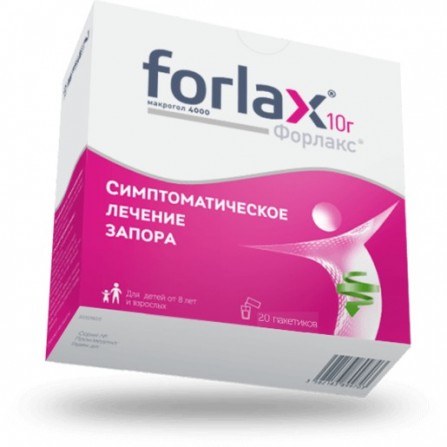Forlax powder for solution pack 10g N20
Condition: New product
1000 Items
Rating:
Be the first to write a review!

More info
Active ingredients
Macrogol
Release form
Powder
Composition
Composition for one package: Active substance: Macrogol 4000 - 10.00 g; Auxiliary substances: Orange-grapefruit flavoring * - 0.15 g; Sodium saccharinate - 0.017 g; * Orange oil, grapefruit oil, orange juice concentrated, citral, acetic aldehyde, linalol, ethyl butyrate, alpha terpineol, octanal, cis-3-hexenol,; maltodextrin, acacia gum, sorbitol (E420), sulfur dioxide (E220), butylhydroxyanisole (E320).
Pharmacological effect
The large molecular weight of macrogol 4000 is due to long linear polymers that retain water molecules through hydrogen bonds. Due to this, the volume of intestinal contents increases after oral administration of the drug. The volume of unabsorbed fluid in the intestinal lumen supports the laxative effect of the solution.
Pharmacokinetics
Pharmacokinetic data confirm that macrogol 4000 is not exposed to either gastrointestinal resorption or biotransformation when taken orally.
Indications
Symptomatic treatment of constipation in adults and children 8 years and older.
Contraindications
severe inflammatory bowel disease (ulcerative colitis, Crohn's disease) or toxic enlargement of the colon, combined with symptomatic stenosis; - perforation or the threat of perforation of the gastrointestinal tract; - intestinal obstruction or suspicion of intestinal obstruction; - abdominal pain of unknown etiology; - hypersensitivity to macrogol (polyethylene glycol) or any of the components; the drug; - children's age up to 8 years.
Use during pregnancy and lactation
Pregnancy; The results of animal studies have shown that Macrogol 4000 does not have a teratogenic effect. Since the systemic effect of the Forlax drug is insignificant, no negative effects on the mother’s body and fetus are expected. Forlax can be taken during pregnancy.; Lactation; The systemic effect of macrogol 4000 on the body of nursing women is insignificant, so a negative effect on the body of the newborn / baby is not expected. Forlax can be taken during lactation .;
Dosage and administration
Inside, the contents of 1 - 2 packages (preferably in the form of a single dose in the morning) or 1 package (in the morning and evening) in the case of receiving 2 packages per day. The daily dose should be adapted according to the clinical effect and can vary from 1 packet each day (especially in children) to 2 packets per day. The contents of each package should be dissolved in a glass of water just before taking. The effect of taking Forlax is expressed within 24 to 48 hours after taking the drug. The recommended treatment for children and adults is 3 months. In children, treatment should not exceed 3 months due to insufficient clinical data. Maintaining the effect after the restoration of normal bowel should be carried out using an active lifestyle and a diet rich in plant fiber. If the symptoms of constipation persist for more than 3 months, it is necessary to conduct a re-extended diagnostic examination.
Side effects
In adults.; Side effects observed during clinical studies on 600 patients had a transient nature, were observed with the following frequency and; mainly concerned the gastrointestinal tract: - frequent side effects (more than 1/100, less than 1/10) : bloating and / or pain, nausea, diarrhea; - rare side effects (more than 1/1000, less than 1/100): vomiting, urgent urge to stool and fecal incontinence. ; Additional information obtained from post-marketing observations included: very rarely (less than 1/10000) cases of hypersensitivity: pruritus, urticaria, transient (transient) rash, swelling of the face, angioedema and individual cases; anaphylactic shock; Unknown frequency of diarrhea leading to electrolyte imbalance (hyponatremia, hypokalemia) and / or dehydration, especially in adults; patients. ; In children; side effects relating to the gastrointestinal tract were minimal and were transient in clinical studies involving 147 children at the age of 6 months to 15 years, were detected with the following frequency: Disorders of the gastrointestinal tract: - frequent side effects (more than 1/100, less than 1/10): diarrhea and abdominal pain.; - rarely encountered side effects (more than 1/1000, less than 1/100): flatulence, nausea and vomiting.; - side effects that are not can be assessed based on available data: hypersensitivity reactions .; Diarrhea can be a cause of pain in the perianal region .;
Overdose
An overdose of the drug leads to diarrhea followed by disappearance after dose reduction or cessation of treatment. Excessive fluid loss during diarrhea or vomiting may require correction of electrolyte disorders.
Interaction with other drugs
Not described. Possible slowdown in the absorption of drugs taken simultaneously with Forlax. It is therefore recommended to prescribe Forlax after, at least 2 hours after the prescription of other drugs .;
special instructions
Special warnings.; Very rare cases of hypersensitivity (including rash, urticaria, edema) have been reported while taking medications containing macrogol (polyethylene glycol). In exceptional cases, anaphylactic shock was observed. Due to the presence of sorbitol, patients with congenital fructose intolerance do not; this drug should be taken. Due to the presence of sulfur dioxide in rare cases, serious allergic reactions and bronchospasm may occur. Aspiration cases have been reported when large amounts of macrogol and electrolytes were administered using a nasogastric probe. .



